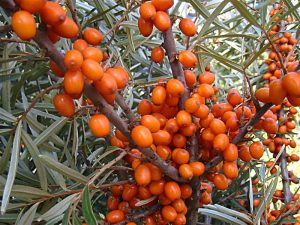Plant of the Week- Sea Buckthorn aka Seaberry
Hippophae rhamnoides or Seaberry is a large, thorny, deciduous shrub native to Europe and Asia. It is a member of the family Elaeagnaceae, which also contains Autumn Olive and Goumi. The yellow to orange berries are extremely high in vitamin C, and is also high in malic acid, making the fresh berries quite sour. The berries and leaves have been used for medicinal purposes in their native areas.
 Seaberry is very hardy, surviving winter temperatures of -40F, and summer heat to 100F. It is tolerant of drought and also of salt spray. The dense, spreading root system make the shrub ideal for erosion control. Because they are nitrogen fixing, they also can tolerate nutrient poor soils.
Seaberry is very hardy, surviving winter temperatures of -40F, and summer heat to 100F. It is tolerant of drought and also of salt spray. The dense, spreading root system make the shrub ideal for erosion control. Because they are nitrogen fixing, they also can tolerate nutrient poor soils.
Male and female flowers are borne on separate plants, so for fruit production, at least one male plant must be planted for every 5-8 female plants. The flowers are wind pollenized and not attractive to pollinating insects.
One of the most difficult parts of growing seaberry is harvesting the berries. The long thorns protecting the berry clusters make them difficult to hand harvest. The berries are mostly used for processing; jams, sauces, juice, and other cooked products. One harvesting strategy is to cut whole branches and freeze them. The frozen branches can then be hit on a hard surface to release the berries.

